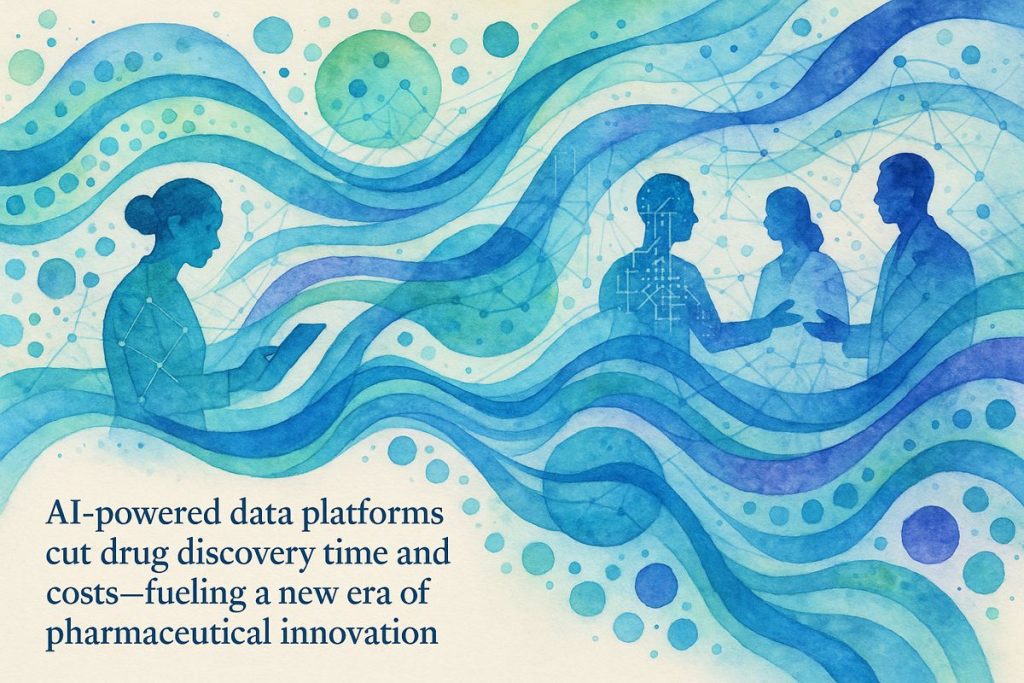Pharmaceutical research used to be slow and expensive, but now advanced data platforms and AI are making everything faster and smarter. These new tools help scientists analyze huge amounts of data, find better drug candidates, and even adjust clinical trials in real time. But fancy technology isn’t enough—true breakthroughs happen when people from different fields team up and share ideas. In this new era, it’s all about mixing human creativity with powerful machines, and sometimes learning from mistakes (and cold coffee) along the way.
How are advanced data platforms and AI transforming pharmaceutical R&D?
Advanced data platforms and AI are revolutionizing pharmaceutical R&D by enabling rapid analysis of massive datasets, improving drug discovery accuracy, streamlining clinical trials with real-time data, enhancing collaboration across teams, and ensuring regulatory compliance. This integration accelerates timelines, reduces costs, and increases the likelihood of successful drug approvals.
The Cold Start: A Lab Coat, Some Numbers, and a Muddled Mug
Let’s not kid ourselves—pharmaceutical innovation has long been a slog. Imagine spending two years and $500,000 sequencing a single genome in 2003 (true story), only to watch the price plummet faster than your coffee cools. These days, cloud data lakes (think Databricks, Snowflake) slurp up terabytes of omics data before your espresso even cools to room temperature. But is this glut of hyperspectral information actually catalyzing cures, or are we just spinning petabytes in place? I had to stop and ask myself that last August, after a failed machine learning pipeline left our team staring at a screenful of digital gibberish and—yes—actual cold coffee. Ugh.
Yet here we are in 2024, with pharmaceutical R&D at a crossroads where AI and data platforms promise to shrink timelines, budgets, and the yawning gap between discovery and approval. The scent of possibility (and burned beans) is in the air. But as I’ve learned, sometimes it’s not the slickest algorithm, but a well-tuned human collaboration, that really tips the scales.
The Old Guard Meets the Algorithmic Avant-Garde
Drug discovery used to be a strange blend of artistry and tedium—think of it as Michelangelo meets Sisyphus. Nine out of ten new compounds never see daylight outside the lab, and the cost of shepherding one success from eureka to FDA approval? North of $1.5 billion, if you believe the New England Journal of Medicine. It’s no wonder the industry sometimes feels like a palimpsest of failed hopes and half-remembered trials.
Enter the domain of advanced analytics, where AI doesn’t sleep, and platforms like DataRobot quietly crunch through datasets that would make a 1990s mainframe shudder. Machine learning models—linear regression, random forests, deep convolutional nets—are now part of the pharma vernacular. They don’t just predict which molecules bind to a given protein; they sometimes catch patterns invisible to even the most seasoned computational chemists, like a sommelier detecting the faintest whiff of petrichor in a rare vintage.
But, and it’s a big but: the actor behind the curtain still matters. The best deep learning model is a blunt instrument without the guiding hand of a multidisciplinary team—bioinformaticians, clinicians, regulatory wonks, and, yes, the occasional caffeine-addled data scientist. I’ve been that guy, fumbling a late-night Zoom call with someone from Genentech who casually mentioned their data engineering stack was moving to Snowflake. Jealousy? Maybe a pang. But mostly admiration, laced with the faint aroma of ambition.
Data Lakes, Federated Learning, and a Taste of Tomorrow
The infrastructure underpinning all this is less glamour, more grindstone. Picture a hyperscale data lake: structured and unstructured data swirling together in a digital centrifuge. Want to run a federated learning experiment, sharing insights but not datasets across Novartis or Merck? No problem—as long as your governance is tighter than a Swiss watch. The whir of encrypted data in transit, the click of access logs—these are the sounds of compliance in 2024.
Security and regulatory compliance aren’t afterthoughts, either. HIPAA, GDPR, and their ilk hover like regulatory zeppelins over every innovative leap. Advanced platforms bake in identity management and audit trails, reducing the compliance-induced heartburn that once plagued even the boldest R&D teams. I’ll admit, I once neglected to check data lineage on a cross-institutional project—result: an embarrassing call with legal. Lesson learned, and protocols upgraded.
Now, the pièce de résistance: adaptive clinical trials. By ingesting real-world data from EHRs, wearables, and even social media, trial sponsors dynamically tweak protocols—sometimes mid-study—driven by real-time signals. The texture of this process is oddly satisfying: the clatter of live dashboards, the visual pop of outlier detection, the almost tactile thrill when a recruitment algorithm finally surfaces the perfect patient cohort.
When You Mix Metaphors—And Minds
Still, all the hyperscale hardware and clever code in the world won’t deliver cures if pharma clings to siloed thinking. The era of lone-wolf PI is fading, replaced by what I’d call the “collaborative ecosystem jazz band.” Think interdisciplinary jam sessions, where computational biologists riff with clinicians, and data-savvy project managers noodle through regulatory mazes with a dash of improvisation. When I joined my first such project, I was nervous—how would a machine learning guy keep up with three MDs and an ethicist? But as the session wound on, I felt a surge of camaraderie—and, dare I say, hope.
It’s a messy, imperfect process. Sometimes ideas collide like molecules in a Brownian dance. Not everything sticks. But the emotional payoff when a cross-functional team cracks an intractable problem? Bam! It’s like catching the aroma of freshly ground coffee after an all-nighter—invigorating, fleeting, addictive.
So, if you’re a pharma leader wondering whether to invest in hyperscale analytics or upskill your teams, remember: platforms like Databricks and DataRobot are just the instruments. It’s the music you make—the way you blend tools, talent, and, yes, even failure—that accelerates innovation.
And one last thing, since I promised a quirk: never trust a data scientist who can’t make a decent cup of
